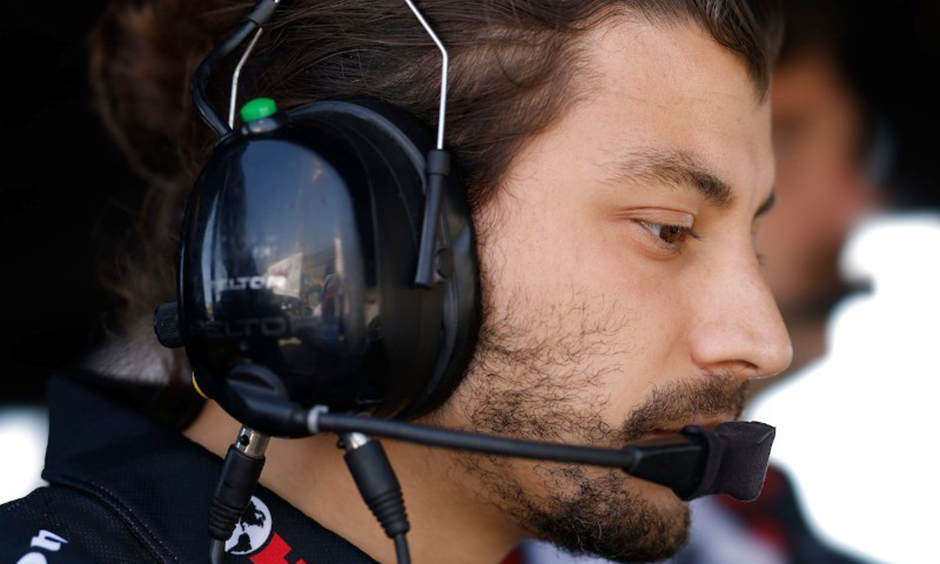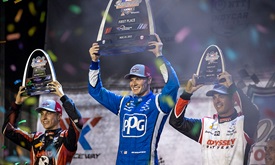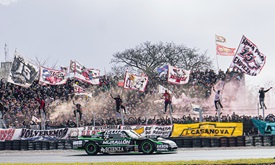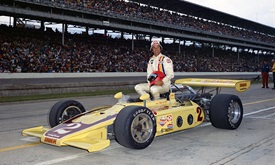The Setup: WWTR with Alex Athanasiadis
AUG 22, 2023
Note: This is a continuing series for INDYCAR.com, with different guests, leading into each race weekend for the NTT INDYCAR SERIES, focusing on various technical challenges of each respective circuit.
The 15th round of the 2023 season for the NTT INDYCAR SERIES heads to World Wide Technology Raceway near St. Louis for the final oval event of the year, this weekend’s Bommarito Automotive Group 500 presented by Axalta and Valvoline.
The 1.25-mile oval that first hosted an INDYCAR SERIES event in 1997 features a front straightaway of 1,922 feet and a back straightaway of 1,976 feet. Additionally, there are only 11 degrees of banking in Turns 1 and 2, with Turns 3 and 4 set at only 9 degrees.
The two-day event features two practice sessions and an NTT P1 Award qualifying bout Saturday, ahead of Sunday’s 260-lap (325 miles) race at 3:30 p.m. ET (NBC, Peacock, INDYCAR Radio Network). The two-lap qualifying record is held by Will Power, who stormed to an average of 189.642 mph in 2017, which also saw him record the fastest flying lap during the run at 189.709 mph on the initial lap.
This week’s featured guest is Alex Athanasiadis, race engineer for David Malukas in the No. 18 HMD Trucking Honda for Dale Coyne Racing with HMD Motorsports. Athanasiadis was the performance engineer for Malukas’ career-best runner-up result at WWTR last year before being promoted to his current role over the offseason.
Q: What is it like preparing for World Wide Technology Raceway?
Alex Athanasiadis: From a preparation perspective, it's not very different compared to any other place that we go to either being a street course, road course or an oval. The one thing that is different from our perspective, we had a very, very strong car there last year. So, it's more about fine-tuning what we know works and adjust for conditions, make sure that we stay on top of track progression and also have the tools and the processes in place for this year's event with the alternate tire for the first time to be able to make efficient decisions and get the setup where David would like it. But in any other place, I would say the first thing I start doing is asking why for every little detail on the car and how that has evolved through the years of this race's history in this place. Honestly, with how competitive we were, it's about fine-tuning and execution rather than turning the car upside down.
Q: World Wide Technology Raceway is nothing like the 1.5-mile high-banked oval at Texas Motor Speedway or as bumpy and short as Iowa Speedway. It’s somewhere in between. So, what is the general rule for setting up a car for WWTR?
Athanasiadis: As you said, it's probably a compromise. And it's in between the other places that we go to. It's only like (an average of) 10 degrees of banking and there is a very, very different radius at Turn 1 and Turn 2 compared to Turn(s) 3 and 4. But just like every other oval, confidence is key. Giving David something that can be aggressive on his inputs, but at the same time smooth and being able to arc the corners is vital. At the same time, the philosophy between qualifying and race is slightly different. We may be able to get away with a balance that is a bit more neutral for qualifying, but at the same time for the race, you will compromise ultimate pace and ultimate performance to be sure that the car is going to be consistent and it's going to inspire a lot of confidence to the driver for 50 laps.
You can definitely ride and have a slightly different platform because the bumps are not as aggressive as Iowa, which is definitely very, very bumpy. At a lot of the places that kind of dictates and takes priority for your set of philosophy and direction. With that being said, obviously at WWTR there's still a lot of load going through, especially the outside tire. So, you need to have a damper that can handle all of that load and make sure that tire has the load when it needs to have it, then it's as consistent as possible. So, yeah, dampers are still important, but I would say from a priority perspective compared to Iowa, for example, probably not up there in the list.
Q: Is aerodynamic or mechanical grip the bigger need there?
Athanasiadis: It's not as black and white, and it's still a compromise. You need to have a setup that you like, with the mechanical grip and the aerodynamic grip working in coherence with each other. The unique thing about WWTR is that the speeds that we go to at Turn 1 and Turn 2 are quite different compared to (Turns) 3 and 4. Aerodynamically, the car sits in a different point of the aero map for those different scenarios. So, you try and work that out and find the nice balance to be sure that entry, mid-corner and exit in all of those corners is the best that it could be.
Q: What is the trickiest part about WWTR?
Athanasiadis: I think it's all down to the details. Obviously, INDYCAR is very, very competitive and the same applies for every place that we go to. If we want to compete at a high level, but especially at a place like WWTR, literally every little detail and the smallest adjustment can make a big difference. A lot of the times from a simulation perspective, getting all of those things to correlate and line up with driver feedback and data from the track is a challenge. So, sometimes something that you will see in simulation or based on your studies is the ultimate setup at the end is not going to inspire confidence to the driver. It's something that you may not end up putting into the car. So, it needs some judgment.
An engineer needs to understand what the driver needs, like in any other place. Thankfully, David, even though he's still very, very young in the series, he's turning out to be quite a specialist on the ovals. So, it makes my job quite easy because immediately he knows what he needs from the car and we can directly, even with a short practice session, get the car to where it needs to be for him to attack and be able to extract maximum performance or prioritize slightly tire life over a race stint when we start looking for a race car.
I think getting each phase of the corner to make sure that the car does what the driver wants to is always going to be troublesome. Turn 1 and Turn 2 having mid-corner speed 20 miles an hour slower than what it is at Turn 3 and Turn 4, making sure that there is enough stability entering the corner so the driver can be aggressive and turn in late without scrubbing too much speed for qualifying. At the same time, have the load on the tire so the car can have a balanced mid-corner and have a nice arc outside of the corner. It's very, very vital. I wouldn't say there is a specific place, a specific bump, a specific corner. It's mostly the layout of the track makes it challenging. And the same thing that applies to any other oval is also applicable for Gateway.
Q: What is the difference between how you set up a qualifying car versus how you need the car to evolve to get the balance right for an entire stint for the race?
Athanasiadis: I would say for qualifying, we are optimizing the car and the balance for two laps. That, in most of the cases, will mean that we will be able to get away with a balance that is a bit more on the edge; something that David will be able to handle for two laps, but may be a bit of a handful for a whole race stint or maybe too tough on the tires. For qualifying, our focus is ultimate pace, make sure we are not scrubbing any speed, make sure that we get the big performance out of the tires for those two laps. Whereas from a race perspective, you're stepping it down a notch and you're trying to have still a good pace, but at the same time you're looking at pace over a 50-lap stint.
So, having a car that is very communicative to the driver and very, very linear on all of its inputs and outputs, it's very, very crucial so David can be doing the same thing lap after lap after lap without degrading one axle compared to the other. And more or less, as the stint progresses, the balance on both ends drops off at a similar rate, which means that he still has adjustment with his tools, and he can stay on top of those and be sure that he has the weight on the tire that needs to have it.
Q: What do you need to have a competitive car at WWTR?
Athanasiadis: Pace and very, very good tire degradation are the two key things there, which is obviously always the case in a short oval. I think last year with David, we managed to do a good step also from his perspective and understanding how he can manage his tools and evolve his driving as the stint progresses to save tires toward the end. Now, we have all of that information and data that we can also direct David, and I can give hints and suggestions on how he can do that even better. So, we make sure that we have tires where it counts, which is mostly toward the end of the stint. A driver needs to be proactive. If you start feeling the understeer building up, it probably means that you have already killed your front right tire.
You need to be proactive, stay on top of your tools and the track evolution. Most importantly, be confident that when you're setting up for a pass, you are actually going to get it done because if you think you're going to get it done and at the end you don't, that puts a lot more energy into the tire, and that's going to hurt you later on for a couple of laps. So, it's about being confident. It's about staying on top of conditions and being proactive. As I said, David has a very, very good feel of what he needs, especially on an oval. I'm sure working together we can build on what we did last year and have a strong result there.
Q: One of the more unique variables this weekend is the addition of running alternate (red sidewall) Firestone tires, paired with the primary (black sidewall). What is the challenge with that, especially being on an oval with that for the first time?
Athanasiadis: It is very, very unique, and I'm sure it's going spice things up quite considerably, especially from a strategy perspective on the race. My focus has been mostly on making sure that the team has the tools and the processes and the responsibilities are very, very clearly outlined so we can do our analysis after we run them in first practice and see how those are like, which is what we normally do either way with the alternates because the information that we are getting from Firestone is very, very limited. With that being said, the first indication, even though we don't have all of the technical info yet, is that the tire is going to be closer to a compound that was used a couple of years ago that was slightly softer.
We have some data that we can start processing, analyzing and trying to understand how those tires will behave. But honestly the answer is that we will not know until we are on the track. The track temp and the ambient conditions also play a crucial role there. So, we are starting with something and a platform that we know, and we can tune off for all of those differences, either being the tire or the track or the ambient or the track temp conditions being different, or even the wind being different. At WWTR, for example, compared to Iowa, the drivers were chatting before and gearing can also be a bit more busy for the driver, and we have different strategy for qualifying compared to what you will be doing in the race. So, having all of those things nailed down also depends on the available grip on the day and how you evolve your setup to account for all of those changes. I think it's very, very interesting what INDYCAR is doing with the alternates. I think it's going to create good racing, and it's just a matter of being there and seeing who is going to react better to those new circumstances.
Q: Each driver has a different style of preferred feel in setup. Some would rather have more understeer and others oversteer, though the goal is always a neutral balance. That said, what have you seen out of David as to what he does particularly well behind the wheel?
Athanasiadis: I think he is definitely one of the drivers that can get away with more oversteer than others. With that being said, especially this year, he's coming more up to grips with the idea that sometimes he needs to be adaptable. And he's great at it and makes sure that he can live with a bit more understeer if that means that the car will be better, for example, over a race distance. He's getting more experience and he's able to understand what he needs from the car even better, which then obviously makes my job a bit easier. He's very good at feeling the combined load of the tire, which into a corner that is very, very crucial. He's also very strong with his throttle application. He's very good at what he does.
I would say if I had very, very generically speaking, putting a comment toward understeer or oversteer, I would say that David prefers a more oversteer car. At the same time, this year he's able to adapt his style when he realizes that that's going be better for our situation and deal with another balance. Obviously, if I could give him the perfect balance every time, this is what we would go for, but sometimes you need to make a compromise so over a race distance or for the specific characteristic of a track, or if you're struggling specifically with one corner compared to the rest of the corners that may be more important for lap time, David is doing a better job keeping up with those.



















